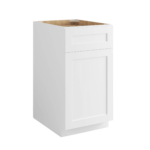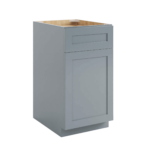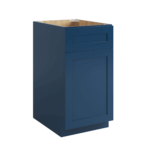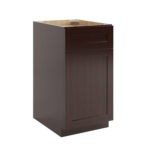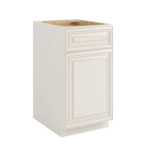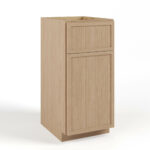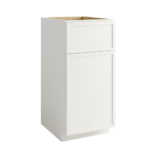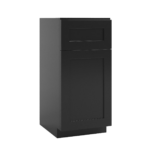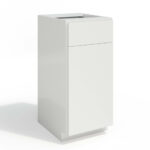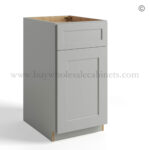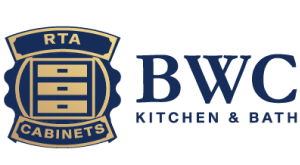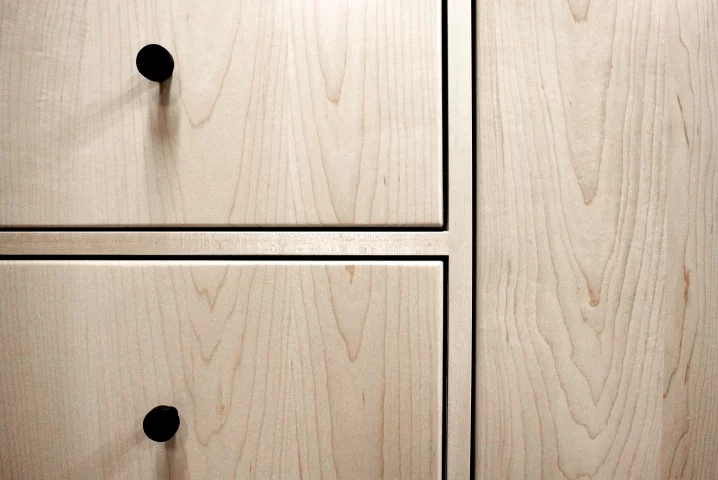The home improvement world is filled with niche terms and options, and it can often be difficult to navigate what everything means and what’s best for you. One of the many options that you’ll face in any home improvement journey is what kind of cabinet you want to feature in your kitchen. While there are countless options for cabinets, including ready-to-assemble (RTA) vs. pre-assembled and various cabinet door styles, people often forget to consider whether they want framed or frameless cabinetry.
A big part of why many people fail to consider their framing options is that many don’t know the difference between or benefits of face frame cabinets vs. frameless cabinets. In this blog, we’ll explain the differences and the pros and cons of each cabinet type, so you can rest assured that you’ll be making the right choice for you when it comes time to purchase your new cabinets.
What are Framed and Frameless Cabinets?
Framed Cabinets
Framed cabinetry, also known as face frame cabinetry, is what it sounds like—these cabinets have a frame between the cabinet box and the doors. The frame looks like a picture frame along the perimeter of the cabinet box. It fits between the box and the cabinet doors, so the cabinet hinges attach to the frame rather than to the sides of the cabinet itself. We’ll explain some of the pros and cons of this cabinet design later.
Frameless Cabinets
Unlike framed cabinets, the door hinges in frameless cabinets are attached directly to the sides of the cabinet. This means that there is no surface between the cabinet door and the cabinet interior.
There are many things to consider when choosing whether you want framed or frameless cabinets, including both aesthetic and practical differences between the two.
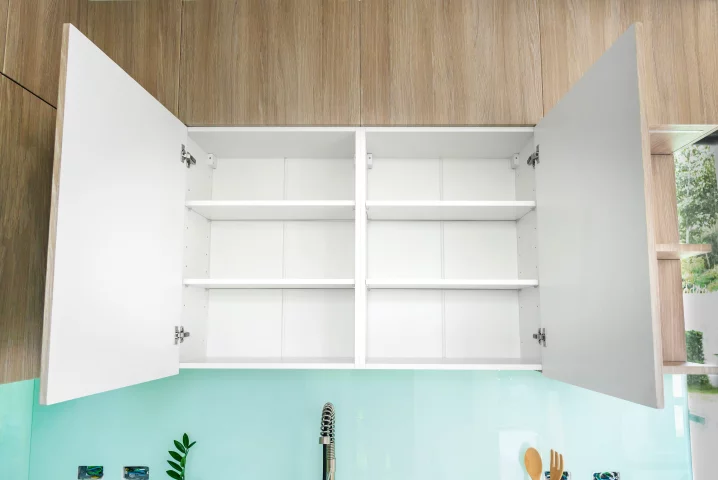
Pros of Frameless Cabinets
Contemporary & Sleek
Many consider frameless cabinets a more modern choice than cabinets with frames because they offer a sleeker and pared-down look. Because there’s nothing between the cabinet box and the door, the cabinet doors in a frameless kitchen stick out less than in framed kitchens. Furthermore, frameless cabinets only come in full overlay, creating the illusion of one nearly seamless wall of cabinetry without gaps or spacing between each door.
Spacious
While the lack of a frame does not create more storage space, it creates the illusion of more space because users have easier access to the interior of the cabinet than they do with frame-face cabinets. This is especially true for cabinets longer than 36”, as cabinets of this length with frames will require a center stile in the middle of the cabinet, which limits what can be placed in the cabinet and where things can be accessed. There is no center stile in frameless cabinets of this length, and all of the space is accessible.
Adjustable
Because the interior of the cabinet is not obstructed by any stiles or rails, shelves can be easily adjusted to fit the specifications of your cabinet contents. Withlarge pots and pans, this can be an advantageous benefit of the frameless cabinet.
Cons of Frameless Cabinets
Less Sturdy
Because the door hinges attach directly to the cabinet sides, any tension put onto the doors will be placing stress on the screws in the cabinet itself rather than anchored in a more sturdy and substantial frame. It’s more likely for a door to come loose or for the screws to cause damage to the cabinet itself in a frameless cabinet.
Racking
Racking is when a cabinet box or drawer is no longer in alignment with the cabinet, making it slide from side to side when pulled out or pushed into the cabinet. Because there is no frame to hold everything in place, a frameless cabinet is more likely to rack when it is not used gently or when it is being shipped.
Bulkier
Although frameless cabinets are known for being sleek, higher-quality frameless cabinets tend to be bulkier than cabinets with frames, as the width and depth of the cabinet’s wood need to be thicker to compensate for the weakness of the connection that the wood makes with the hinges.
Not as Customizable
Frameless cabinets are only available in full-overlay configurations, as partial and inset cabinets require a frame to work. If you want a partial-overlay or inset look, a frameless cabinet is not for you.
Installation Limitations
Because cabinet sides are thinner than a cabinet frame, the screws used in door installation need to be smaller than the screws used for a framed cabinet. Smaller screws are less stable, so there need to be more screws in more places for the hinges to have the same stability as framed cabinets.

Pros of Framed Cabinets
More Durable
The addition of a frame between the cabinet and the cabinet doors creates stability and makes for a sturdier cabinet than one without a frame. The frame is an anchor for the door hinges, which means they’re less likely to come loose or misalign.
Customizable
Framed cabinets are available in all configurations—full-overlay, partial-overlay, and inset. If you want the look of a frameless cabinet with the durability of a frame, a full-overlay frame face cabinet will achieve nearly the same aesthetic.
More Options
Framed cabinets are considered the American style of cabinets (compared to the European frameless cabinet), so they tend to be more widely available in the U.S. There are many different framed door styles to choose from, as opposed to the slightly more limited selection of frameless cabinetry.
Less Racking
Because the frame serves as a guide for the cabinet drawers when they’re being pulled out or pushed in, framed cabinets are less likely to experience racking or misalignment during shipping or daily use.
Installation
The addition of a frame provides more wood for the hinges to attach to, meaning that the screws used in installation can be longer than those used for a frameless cabinet. This means that there do not need to be as many screw sites when installing a framed cabinet, making installation a more straightforward process.
Cons of Framed Cabinets
Less Spacious
On average, a cabinet frame takes up around ½ of an inch around the perimeter of the cabinet’s interior space. If you include a center stile in the middle of the interior space, you will have a potential obstacle to certain dishes, pots, or pans. While there is still the same amount of space inside the cabinet, the front of the cabinet space may be slightly obstructed.
Frame Lip
The frame of a framed cabinet forms what is called a “frame lip,” or the ½ inch perimeter of the cabinet that we mentioned earlier. Some users dislike this lip because one cannot slide plates or dishes directly into or out of the cabinet, as the lip obstructs the edge of the cabinet itself. However, some cabinet manufacturers will sand down this lip to avoid any difficulties for the owner.
Framed Cabinets at Buy Wholesale Cabinets
Now that you know the ins and outs of cabinet construction, you have a better idea of which type of cabinet is better for you: face frame cabinets vs. frameless. While it’s ultimately a personal choice, many of these logistic pros and cons may assist you in your decision between framed vs. frameless cabinets.
When you’re ready to purchase high-quality, affordable cabinetry, Buy Wholesale Cabinets has a premium selection of face frame cabinets at low prices that never sacrifice quality. We pride ourselves on fast shipping, amazing customer service, and quality that can’t be beat. Shop our online collection of Shaker white and gray cabinets now to see the value, and contact us for a free quote today!
